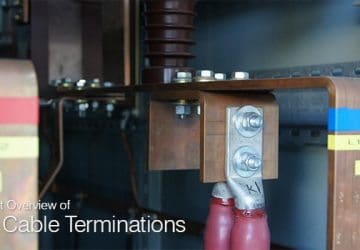Principles and Characteristics of Distance Protection
Distance relays are one of the most important protection elements in a transmission line. These relays may sometimes be set based in percentages of the line impedances, for example a typical setting for zone 1 is 80% of the impedance… Read more
Nov 13, 2012 | By Edvard Csanyi

Electrical Safety Standards for LV/MV/HV (Part-2)
Continued from part 1 – Electrical Safety Standards for LV/MV/HV (Part-1) Standard: Northern Ireland Electricity (NIE), 6/025 ENA Clearances of Electrical Line to Ground and Roads Clearances of Electrical Line to Other Objects Clearances of Electrical Line to Trees and… Read more
Nov 12, 2012 | By Jignesh Parmar

Steps to Ensure Effective Substation Grounding (Part 2)
Continued from previous article: Steps to Ensure Effective Substation Grounding (1) In previous technical article (part 1) was explained first five steps that will ensure a reliable, safe and trouble-free substation grounding system. Here we will explain the last six steps:… Read more
Nov 10, 2012 | By Edvard Csanyi

Steps to ensure effective substation grounding (Part 1)
An electrical substation is a critical resource in a power system. Safe operation of a substation calls for a properly designed and installed grounding system. A well-designed grounding system will ensure reliable performance of the substation over its entire service life. How does… Read more
Nov 09, 2012 | By Edvard Csanyi

How to Dim LED Lighting in the Home?
LED lighting in the home is becoming more popular due to the energy and money saving benefits it offers over traditional halogen lighting. One of the most common problems that an electrician faces when installing LED’s is enabling them to… Read more
Nov 08, 2012 | By Joe Watts

Electrical Safety Standards for LV/MV/HV (Part-1)
Standard: Western Power Company Water Safely Clearance on Electrical Fires Minimum Approach Distance for Authorized Person Minimum Approach Distance for Ordinary Person Minimum Approach Distance for Vehicle and Plant for Ordinary Person . Standard: New Zealand Electrical Code Min. Safe… Read more
Nov 07, 2012 | By Jignesh Parmar

Few Words About Synchronous Machines
There are two main types of synchronous machine: cylindrical rotor and salient pole. In general, the former is confined to 2 and 4 pole turbine generators, while salient pole types are built with 4 poles upwards and include most classes… Read more
Nov 06, 2012 | By Edvard Csanyi

Aluminium and its Alloys used in Electrical Engineering
Aluminium has been used for many years as a conductor material in almost all branches of electrical engineering. In addition to the pure aluminium, several its alloys are also excellent conductors, combining structural strength with an quite acceptable conductivity. Aluminum… Read more
Nov 05, 2012 | By Edvard Csanyi

Application of Circuit Breakers in IT Networks
IT supplies are used to prevent that a ground fault leads to immediate disconnection of the affected circuit like in a grounded system. Although a first ground fault results in a displacement of the potential of the entire supply, continued… Read more
Nov 03, 2012 | By Edvard Csanyi

Motors for Hazardous Areas
Electrical drives/motors that are operated in hazardous areas must be built and engineered so that they cannot become an ignition source. This applies not only to normal operating and starting, but also in case of faults, for example at stalled rotor. The… Read more
Nov 02, 2012 | By Edvard Csanyi

Transformer Differential Protection Principles
Similar to bus protections, transformers are protected by differential relays. Inter-winding faults (short circuits) and ground faults within power transformers can be detected by this protection scheme. Failure to detect these faults and quickly isolate the transformer may cause serious… Read more
Nov 01, 2012 | By Edvard Csanyi

Application of 4-pole Switchgear Devices
The majority of low-voltage switchgear is equipped with three contacts in the main circuit, which switch three-phase loads in all poles. In some applications switchgear with four main poles is required, either for safety reasons or for an optimum solution… Read more
Oct 31, 2012 | By Edvard Csanyi

Smart and safe protective shutdown of LV system with selectivity
From the point of view of the operational safety and reliability of an entire low-voltage installation, it is usually desirable to specifically isolate the part of a system affected by a short-circuit in order to prevent spreading of the fault. Selectivity… Read more
Oct 30, 2012 | By Edvard Csanyi

Transformers Are Never Silent
Yes, we all know that transformers are never silent. This is actually quite impossible, but in an environmentally aware, highly regulated world, the issue is not the level of noise, but its nature – and it’s very important. Transformers emit… Read more
Oct 29, 2012 | By Edvard Csanyi

Short Overview of LV Cable Terminations
A termination is the electrical and physical connection of a cable end to a piece of equipment or another cable. A splice is the electrical connection of a cable end to another cable with the same cable number. Cable terminations (splices) are… Read more
Oct 27, 2012 | By Edvard Csanyi


